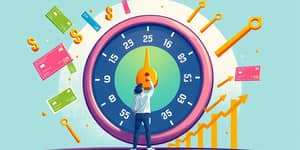Student loan debt has become a defining challenge for millions of Americans, shaping career decisions and financial stability. In 2025, the total burden has soared to $1.81 trillion, leaving many borrowers seeking clarity and relief. This article offers a roadmap to manage and conquer that burden.
Understanding the Student Debt Landscape
The U.S. student loan ecosystem in 2025 encompasses 42.3 million federal borrowers, carrying an average debt of $39,075. When private loans are included, the average climbs to $42,673. Notably, 3.6 million borrowers owe more than $100,000 each. These figures underscore the sheer scale of the challenge.
Demographically, over half of federal borrowers are over the age of 35, and 20% exceed age 50. Black students often graduate with higher balances, and for-profit college attendees disproportionately carry debt. With a 31% delinquency rate (90+ days past due), many face credit score drops averaging 60 points, hampering long-term financial prospects.
Beyond raw numbers, the emotional toll of debt can delay homeownership, marriage, and retirement planning. Many borrowers report anxiety related to monthly payments and uncertainty about future policy changes. Acknowledging this stress is the first step toward crafting a sustainable repayment journey.
Choosing the Right Repayment Plan
Selecting a repayment plan can feel like navigating a maze. Standard repayment offers a fixed schedule over ten years, making it the fastest payoff method but with higher monthly obligations. Graduated repayment eases initial payments, raising them every two years, while extended repayment stretches terms up to 25 years for balances above $30,000.
Income-Driven Repayment (IDR) plans provide relief based on earnings. Under options like Income-Based Repayment (IBR), Pay As You Earn (PAYE), and Revised PAYE (REPAYE), payments can be capped at a percentage of income. Forgiveness of remaining balances occurs after 20 to 25 years of qualifying payments, and those forgiven amounts are currently tax-free through 2025.
Consider a mid-career professional earning $60,000 annually. By enrolling in an IDR plan, they might pay only $350 per month instead of $600. These savings could fund emergency savings or accelerated retirement contributions. Conversely, a recent graduate with high starting salaries may prefer the standard plan to minimize total interest paid.
Forgiveness and Cancellation Pathways
For borrowers dedicated to public service, the Public Service Loan Forgiveness (PSLF) program promises erasure of balances after ten years of full-time public service on an eligible IDR plan. Teachers, nurses, and government employees can pursue this route, ensuring tax-free forgiveness.
- Public Service Loan Forgiveness: 120 qualifying payments
- Income-Driven Repayment Forgiveness: 20–25 years on IDR plans
- Teacher Loan Forgiveness: Up to $17,500 after five years
- Other Discharges: Closed schools, disability, borrower defense
Navigating forgiveness requires meticulous record-keeping. Submit annual employment certification forms, track each payment, and confirm that you meet eligibility criteria. Small errors can reset progress; vigilance is vital. Leveraging servicer portals and official tools ensures that no qualifying payment goes uncounted.
Strategies for Private Student Loans
Private loan borrowers confront fewer federal protections, but options still exist. Refinancing can secure lower interest rates for those with strong credit, though it sacrifices federal relief perks. Hardship or forbearance programs may be available directly through lenders, but terms vary significantly.
- Refinance to potentially lower rates
- Negotiate hardship forbearance options
- Compare lender programs before committing
Before refinancing, review the fine print. Some lenders impose origination fees or require collateral. Evaluate whether the interest savings outweigh the loss of benefits such as deferment or IDR eligibility. In some cases, a hybrid approach—refinancing only a portion of the balance—can balance flexibility and protection. Seek guidance from a certified financial counselor before making major decisions; free or low-cost advice may be available through community organizations and nonprofits.
Psychological and Practical Survival Tips
Debt can create stress, but a proactive stance restores control. Begin with a clear inventory of all loans, noting balances, interest rates, and servicer contacts. Use official resources to verify details and authenticate eligibility for relief programs. Contact servicers at the first sign of hardship to explore deferment, forbearance, or IDR enrollment.
- Use the PSLF Help Tool for verification
- Document all communications and confirmations
- Guard against scams: avoid falling into repayment scams
- Align career and location choices with forgiveness goals
Incorporate budgeting methods such as the debt avalanche or snowball to gain momentum. Celebrate small victories—paying off a single loan or reducing a balance by 10% can boost morale. Joining peer groups or online communities also provides emotional support and accountability.
Staying Ahead: Policy Outlook and Action Steps
The legislative environment around student loans remains dynamic. Proposed changes to IDR, PSLF, and new Repayment Assistance Plans under consideration demand borrower vigilance. Engaging with advocacy groups and staying informed through official channels can yield advantages.
Amid uncertainty, adopting a mindset to navigate complex policy changes skillfully can make the difference between stagnation and success. Regularly review your plan, adjust as income shifts, and be ready to exploit new relief opportunities as they arise. Contact elected representatives to voice support for policies that benefit borrowers.
Student loan repayment need not feel like an endless tunnel. By combining data-driven strategy with adaptability and perseverance, any borrower can transform debt into an opportunity to build long-term financial stability and freedom. The road may be long, but each step forward brings you closer to a future unburdened by debt.
Take control of your financial destiny by inventorying your loans today, selecting an optimal plan, and leveraging every available resource. With informed planning and sustained commitment, you can conquer your debt and reclaim your independence.
Every year, hundreds of thousands of borrowers successfully complete their repayment journey, emerging debt-free and ready to pursue new goals. By applying these strategies, you join a community committed to financial wellness and generational impact.
Embrace the process; your determination will pave the path to debt-free living.
References
- https://www.bestcolleges.com/research/average-student-loan-debt/
- https://www.nerdwallet.com/article/loans/student-loans/student-loan-forgiveness
- https://newsroom.transunion.com/june-2025-student-loan-update/
- https://www.attorneygeneral.gov/ffel/
- https://educationdata.org/student-loan-debt-statistics
- https://www.nationaldebtrelief.com/blog/debt-guide/student-loan-debt/how-to-apply-for-student-loan-forgiveness-in-2025/
- https://educationdata.org/average-student-loan-debt
- https://fsapartners.ed.gov/knowledge-center/library/dear-colleague-letters/2025-07-18/federal-student-loan-program-provisions-effective-upon-enactment-under-one-big-beautiful-bill-act










